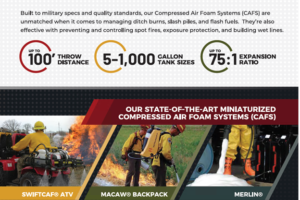Ready for Wildfire: Prepare and Protect
Fire is, and always has been, a natural part of the Wildland Urban Interface (WUI). However, as climate change continues to worsen, so do the length and size of wildfires. The prime reason? Longer, hotter summers. Higher temperatures have been linked to more frequent and severe wildfires and climate change is creating ripe conditions for them. More days of extremely hot weather mean more dried-out forests and grasslands ready to burn.
Home Insurers Are Opting-Out
Now homeowners are facing yet another obstacle and risk— getting and keeping fire insurance for their homes. Many insurers are choosing not to renew policies, raising rates by astronomical amounts, or policy refusal altogether for homes in the WUI. In 2016, up to $285 billion in economic losses were caused by fire-related deaths, evacuations, and declining property values. Insurance companies are either playing catch-up to the demands of climate change or widely ignoring it.
The denials and increasing rate of home insurance premiums in the WUI only add to the trauma and loss homeowners and their families face during wildfires.
So what’s a homeowner to do?
Many are left with no choice but to take matters into their own hands. WUI homeowners across the U.S. are banding together to support each other by creating firewise communities to come up with an attack plan and keep their homes and communities safe.
Keeping Your Home and Communities Safe in the WUI
Thankfully, there are steps you can take to greatly increase your safety and the survivability of your property. It starts by having the right tools and preparing well in advance of a wildfire.
Here are some steps that can be taken to improve the survivability of your home starting today:
- Remove flammable material from around your house, make sure there is no tinder under the porch, or in the gutters.
- Plants near your house should be suited to the current environment, have as much moisture as possible, and be kept short, with dead brush cleaned out.
- Keep a larger foot perimeter (60ft +) around your house clear of large trees to create defensible space around the home.
- Trim grass to a low height.
- Ensure windows and doors are sealed properly when closed.
- Close attic vents to keep flying embers out. Firefighters will often bypass attempting to save a house if the attic is already compromised by flames.
Even if preparations may not save the house on its own, fire crews will do as much as they can to triage houses. And the ones with defensible spaces are much more likely to get resources to defend them, than ones covered in trees.
A Case for CAFS
Compressed Air Foam Systems (CAFS) has reinvented what water can do. A CAFS is a standard water pumping system that has an entry point where compressed air can be added to a solution to generate foam. CAFS will propel foam much farther than traditional aspirated water nozzles like a standard garden hose with limited reach. Your best bet is to invest in a good set of wildland fire tools like a portable CAFS that’s ready for rapid response.
The Macaw® Backpack by Intelagard is a compact, totally independent CAFS that is versatile and easy-to-use. More powerful than standard extinguishers, the Macaw® can be used for fire suppression and provide exposure protection for you, your home, and your community. It can multiply 5 gallons of water up to 175 gallons of finished foam. A much more effective tool than a run-of-the-mill garden hose.
If you or your Firewise community has access to an ATV or UTV, the SwiftCAF ATV and Merlin MP CAFS can turn them into a first-response fire apparatus. These portable CAFS combine performance with impressive fire extinguishing capabilities. They deliver large quantities of solution to attack wildland and structural fires that previously required massive tactical operations and manpower.
Be Ready To Make the Call
When it comes to disaster response, evacuation orders are tricky. There’s strong pressure to only evacuate the minimal amount and avoid false alarms. However, once you become aware of the fire, you need to make your own evacuation decision, and if it is heading your way (or close enough that a wind-shift could send it your way in the next day), get out, and don’t wait for official orders.
If you aren’t under any imminent threat but happen to come under an ember attack or encounter spot fires on your property, having a Compressed Air Foam System can be the game-changer that prevents fires from getting out of control. You don’t need to waste massive amounts of water to defend your home if you take the right steps to mitigate the chance of fire spreading with CAFS.
Connect with a distributor today to learn more about how CAFS can help keep your home and communities safe.
Call Us Toll Free: 800.468.6090
Email Us at info@intelgard.com
Sources:
https://disastersafety.org/wildfire/
https://nvlpubs.nist.gov/nistpubs/SpecialPublications/NIST.SP.1215.pdf

